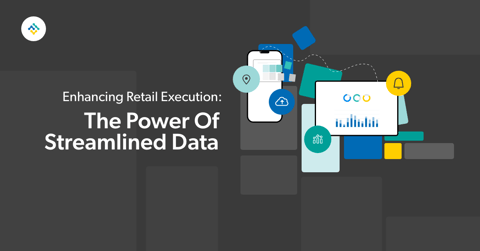What comes to mind when you think of merchandising? Is it eye-catching window displays and holiday promotions? Or maybe cross-merchandising and dump bins? While these things surely contribute to a successful strategy, true merchandising experts have a few tricks up their proverbial sleeves that many may overlook.Going beyond simple visual merchandising, we got the lowdown from those at the top of the merchandising field on what they do -- both on the shelf and off -- to secure facings and get their products into the hands of shoppers.
Read on for inspiration on how to execute at retail and boost your brand’s influence in the market!
1: Make Sure Your Shelf Looks Great First
Before anything else, top brands make sure their products look great on their home shelf. This is where the majority of shoppers will make their decisions, so having a sharp retail display is extremely important. Take it from specialty snacks brand 4505 Meats -- they let us in on their “pop and lace technique,” which sets a standard for how their products should look on the shelf. Using this method, 4505’s reps have a simple strategy in place to ensure consistent presentation across retailers.
How:
Come up with a set of standards for your product displays. Super-selling health food brand RXBAR’s reps share photos of their visual merchandising techniques with each other so they can replicate success in multiple locations.
“Our biggest advantage is when we can share photos and data so that we can tell a story from one store that’s being successful into the next,” says Corey Baker, Territory Sales Manager at RXBAR.
2: Look For Off-Shelf Potential
Once you’re sure that your home displays are up to par, you can focus on looking for off-shelf potential. Finding additional points of interruption in the store can be a huge win for your brand, as it can help you convert shoppers who otherwise may not have sought out your products. As Jack Peters, Marketing Manager at Protein2o pointed out, your products may not always be eye-level in the aisle, so securing facings in an end cap or cooler display can make a huge difference in sales.
How:
Consider teaming up with another brand and engaging in some cross-merchandising. If you can get your organic pita chips into a cooler extender display next to the hummus, you’re opening up a huge opportunity for shoppers to opt for your product over a competitor’s.
3: Ensure Retailer Compliance Through Strong Relationships
50% of in-store displays are non-compliant, which is why strong retailer relationships are key when it comes to successful merchandising. If the store owner likes and respects your brand, they are more likely to feel invested in your displays and help drive store traffic to your products. But don’t take it from us -- take it from the merchandising experts at Spindrift:
“The most important thing from our standpoint is building those relationships with the key decision makers and ensuring that the product is properly displayed and meeting our merchandising standards,” says Connor Rummler, Regional Sales Manager at Spindrift.
How:
Use technology such as GPS tracking and data analytics to optimize your account visit schedule. For example, the sales team at Harney & Sons uses GPS technology and route optimization tools to plan their retailer visits. This allows them to take advantage of opportunities to visit stores that may not have originally been on their docket but that would benefit from a check-in while a rep is in the area.
4: Use Data to Earn More Facings
How:
Telling a data story as part of your retail merchandising strategy is more of a long-term project than setting up an end cap, but it is exponentially valuable. Combining storytelling with your data gives you the power to not only show how your product is performing but also explain the value your data provides. Familiarize yourself with the three types of performance data: Observational, Activity, and Sales Data. Observational data refers to what can be observed by reps in the store; Activity data refers to the specific activities reps are doing in the field to drive sales; Sales data tracks the velocity of sales. All three work together to generate your data story. To ensure clear communication of these metrics, create a digestible fact sheet to present to retailers when securing new facings.
5: Market Within the Retailer
Unsurprisingly, most purchase decisions are made during a customer’s in-store experience. This is why spending some of your marketing dollars on visual merchandising displays and in-store advertisements is a great idea.
“The majority of our marketing dollars are spent within the four walls of the retailer,” says Matt Swanson, CEO & Co-Founder of Rethink Water. “We do a lot of in-store promotion -- TPR and TPC -- and we love to get as much off-shelf placement as we possibly can. Data drives everything we do. It helps us decide where we want to go, what we want to do, and where we want to win.”
How:
There is plenty of room within retailers to take over with well-placed marketing materials. Be proactive before asking a store owner if you can advertise in-store by scoping out a few ideal spots for a poster or to run a product demonstration. When you go to ask the retailer for the opportunity, they’ll appreciate that you took the time to get to know the store and to find a location that works for both of you.
6: Connect With Store Staff
Quality retailer relationships don’t start and end with a general manager. All of the in-store employees where your product is sold should feel connected to your brand on an individual level.
“Finding the high-traffic areas in the store, connecting with the staff so they can talk about our products when we’re not there, and then landing that placement is really key,” says Viva Energy’s Founder, Ryan Nelson.
How:
Next time you do an in-store visit, try to talk to the staff personally about your brand. Take it a step further by providing them with a fact sheet about your company and products, and get them excited by offering samples.
7: Look at Your Competition
The saying goes, “if you can’t beat them, join them.” But why not do both? Use your competition as a guide for spotting trends and keeping up with customer needs.
Take successful snack food brand Brad’s, for example: “We look at the competition a lot to see where they're priced [and] how often they’re promoting,” says Dustin Canner, the brand’s VP of Natural Sales.
How:
One great way to spy on your competition is through social media. If your toughest challengers have started putting up elaborate holiday displays, consider what your team can do to replicate and improve upon their strategy.
8: Know Store Velocity
Avoid the frivolous spending of your company’s budget by using data to make informed decisions about which retailer locations to focus merchandising efforts on. Store volume and velocity data will be extremely informative; If you know that one location is getting double the foot traffic of another, you can focus in-store efforts at the high traffic location, getting the most bang for your buck.
“We measure velocity very heavily, and in places that we know the velocity can improve, we push hard for off shelf activity,” says 4505 Meats’ Director of National Accounts, Adam Bailey.
How:
Keeping track of store data is imperative if you’re to make informed decisions. It is not enough to just estimate. High performing brands have invested in data collection tools and work on having all of their in-store decisions backed by data that proves they’re worth the investment.
If improving in-store execution is your destination, a strong retail merchandising strategy is the vehicle that gets you there. To hear even more retail merchandising tips from the experts themselves, check out the full highlight reel below!

![8 Retail Merchandising Tips These Sales Experts Swear By [Video]](https://391043.fs1.hubspotusercontent-na1.net/hub/391043/hubfs/frankfeatureimage.png?width=1200&height=630&name=frankfeatureimage.png)


